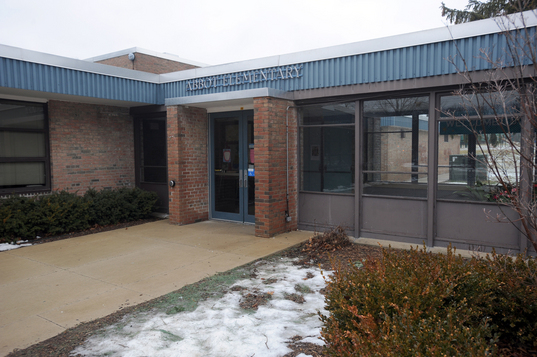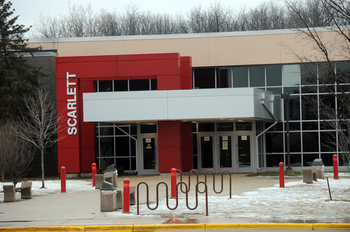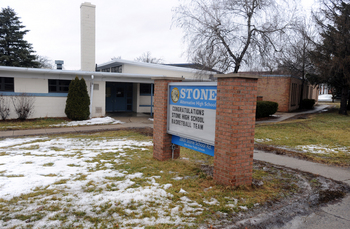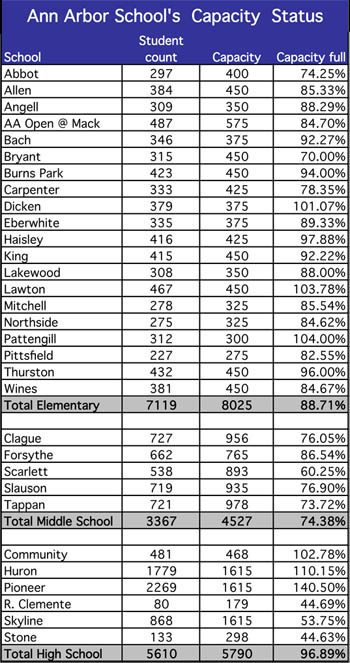Ann Arbor school buildings 87.8% full; superintendent says closures not needed to balance budget

Abbot Elementary School has one of the lowest capacity ratings in the district at less than 75 percent full.
Lon Horwedel | AnnArbor.com
The Ann Arbor school district can cover its almost $20 million budget deficit this year and next without closing an elementary school, Superintendent Todd Roberts says.
But what happens after that remains a big question mark as the district copes with a ongoing budget crisis.
District officials did say reviewing how each school-owned building is currently being used would be part of a review by a task force being formed this spring to evaluate how the district is doing on following its strategic plan.
A blue-ribbon panel met in 1985 and 1986 to make a similar study. Out of that recommendation, seven buildings were closed - the last time any Ann Arbor school buildings were closed, district officials said.
Ann Arbor parent William Roston, who has two sons in elementary school in the district, said he’s glad to hear schools likely won’t be closed in the near future. But he also sees why school closings could be considered.
“It’s good, because we don’t have to worry about the kids going somewhere else and not having a neighborhood school, but I think there’s plenty of room in lots of these schools, and the district could really save money by closing them,” Roston said.
The numbers
If all the classrooms in Ann Arbor school buildings were at capacity, the district could hold well over 18,000 students - about 2,000 more than it currently has.
Ann Arbor’s schools are now running about 87.8 percent full, according to documents prepared by the district.
The district uses a state formula in bond applications to determine capacity numbers, said Randy Trent, the district’s executive director of physical properties. That formula works out to about 25 students in a room for elementary schools. Building capacity is determined by multiplying the number of rooms - minus spaces for things like resource rooms, media centers and other non-classroom spaces - by 25.
The capacity rate varies building-by-building, even when comparing elementary, middle and high schools.
The district is overflowing at the high school level. It is about 97 percent full, even when taking into account the relatively low capacity rate at Skyline and Stone high schools, along with the Roberto Clemente Development Center.
That’s because both Pioneer and Huron are well above capacity. The numbers will change in the next two school years as Skyline becomes fully populated with students.

Scarlett Middle School is currently only 60 percent full, the lowest of the middle schools in the district.
Lon Horwedel | AnnArbor.com
Roberts has already proposed looking at how the district handles alternative education at the high school level. Some staff members are speculating that Clemente and Stone, which both serve alternative students, will be combined.
At the elementary level, the district is at about 89 percent full, district records show. There’s room for about 900 more elementary school students in the district.
Capacity ranges widely between schools. At Pattengill, Lawton and Dicken, the capacity rate is over 100 percent, whereas at Bryant, the rate is 70 percent.
Pattengill and Bryant are paired schools. Students go to Bryant for kindergarten through second grade, then move to Pattengill for third through fifth grade.
The biggest capacity hole comes at the middle school level, where the district is only 74 percent full.
“There just doesn’t seem to be as many students in the hall when I go to visit my son as there were a few years ago when my daughter was there,” said Ricky O’Neil, whose son goes to Tappan Middle School.
The money
Closing a school wouldn’t fix the entire budget problem, district officials said. It would only save about $600,000 a year out of the operational budget.
Selling a school can generate additional income, but that’s a one-time only fix, district officials said.

The district is exploring how to more efficiently provide an alternative high school. The district currently has Roberto Clemente and Stone, which is just 45 percent full.
Lon Horwedel | AnnArbor.com
And in a tough economy, there’s no guarantee schools will sell. For example, both Ypsilanti and Willow Run have recently closed elementary schools, and both have struggled to find buyers for them.
That said, if the district decides to close a school, it will look at a number of factors, Roberts said. He added there’s no magic capacity rate that would automatically trigger a closure if the school fell under that number.
“It’s more about trends,” he said. “Is there a falling enrollment over a number of years? What does the demographic projections tell us are coming? It’s also about what’s cost-effective and what fits our program. They all go into determining whether we would close a building.”
• Map of Ann Arbor's schools

David Jesse covers K-12 education for AnnArbor.com. He can be reached at davidjesse@annarbor.com or at 734-623-2534.



Comments
PhillyCheeseSteak
Thu, Feb 4, 2010 : 1:34 p.m.
And yet Pioneer has more students than either Huron or Skyline, so why put Rec & Ed there? Why not at Tappan M.S. or Scarlett M.S. which are hundreds of students below "capacity". Also, why did they convert Pioneer's "E" hall rooms from vocational classrooms to regular classrooms? Is it because ALL Pioneer student go on to traditional 4-year colleges/universities? Will our future not allow real-world smart Pioneer students to learn vocational trades?
Andrew MacKie-Mason
Mon, Feb 1, 2010 : 9:31 p.m.
If you look at the official headcount numbers on the WISD website for the past ten years and take the maximum numbers for each school, the capacity is actually 19,486. That means that the district is actually running at just over 82% capacity. The district may have their "ideal" capacity numbers, but they aren't real capacity. There needs to be an independent analysis of real capacity by local business leaders and students who actually know how school space is used on a day to day basis.
Andrew MacKie-Mason
Mon, Feb 1, 2010 : 9:20 p.m.
The "over capacity" myth is just that: a myth. I'm a senior at Pioneer High School, and I can assure you that it is not over capacity. Crowded, yes. Over capacity? Not even close. They're in the middle of getting rid of classroom space, both through demolishing E Portable (which had some of the most comfortable rooms in the building) and using E hall for other things, like Rec & Ed. Pioneer is under capacity, not over. It's not even a question of "cramming kids in". There are empty desks in class rooms all the time.
PhillyCheeseSteak
Mon, Feb 1, 2010 : 2:15 p.m.
Isn't it ironic that Pioneer High School, over-capacity with 2,000+ students, is the NEW home of the public school's "Rec & Ed" department? How can this be?
owlnight
Mon, Jan 25, 2010 : 10:29 p.m.
" The AASD can cover its almost $20 million budget deficit this year and next without closing an elementay school. Superintendent Tod Roberts says"......Does that mean that the custodian and maintenance have to give up 23% or the aaps will privatize......that means 166 people have to loose almost 1/4 pay saving 2.5 million....teachers 4% for 1219 people for 5 million. This was shown Jan. 19 2010 Pioneer but without the workers numbers.
Andrew Thomas
Mon, Jan 25, 2010 : 7:45 p.m.
An overall utilization of 87.8% really isn't bad, anytime you get utilization over 90% you start having conflicts, inefficiencies, etc. I agree that the middle schools in particular seem underutilized, but closing a building at this time would be disruptive and needs to be thought through carefully. As for Stone and Clemente, this decision should be made primarily based on a programatic basis (how can we best serve the needs of these at-risk students) rather than just on budget issues.
Steve Norton, MIPFS
Mon, Jan 25, 2010 : 4:52 p.m.
@aaconcerned, I was thinking mostly about conventional elementary school buildings, since they make up the largest number of buildings. Stone and Clemente serve different student populations (kids coming back to school to finish after an interruption, in the first case, and kids who are having real trouble in school, in the second). But both are geared toward giving young people a second chance. I think that's something worth investing in. Whether we need two buildings for that, or not, I'm not really qualified to say. I imagine there would be risks in putting both programs in one building, but there might be benefits as well: perhaps seeing older kids making the effort to finish school might help the younger, struggling kids think about their priorities. @YpsiLivin, I didn't say losing 60 students would be catastrophic, I just said that it would nullify the savings from closing a building. Just as the district would not have to spend the $600,000 in the future, it also would not have the $600,000 in income those students would have brought in in the future. Remember that "capacity" is measured in rooms, not space for students, and that the formula assumes each "classroom" can hold 25 students. So far, AAPS is trying to keep the average class size at elementary schools lower than that, and even then we are having 4th and 5th grade classes of 30 or more kids. Raising those numbers will not attract families to AAPS. As to the empty rooms: schools which have "capacity" do not have lots of very small classes. They have classes roughly the same size as anywhere else in the district, with a few unused rooms available. The marginal cost of having an empty room is minimal. The potential costs in students (and therefore budget funds) of a wholesale restructuring of our school districts is much larger. That's why it makes more sense to try to attract new students, including possibly kids from other districts, to fill those empty classrooms. About ten kids would pay for the extra teacher required; more than that would be a net gain for the district. My warning was to look at the experience of some of our neighboring districts which have been losing large numbers of students (Ypsilanti and Willow Run). The loss of students requires immediate budget cuts that exceed the savings from having fewer students. This "death spiral," as I call it, has nearly destroyed Willow Run and is currently threatening Ypsilanti. AAPS is fortunate, because our employment base is not eroding as rapidly as it has in eastern Washtenaw County; that means that we are less vulnerable to rapid out-migration. But there will be challenges, including long-term demographic trends. We need to ask ourselves, honestly, if good schools are really a luxury we can no longer afford, or if they are the foundation of a strong and prosperous community.
Chris Blackstone
Mon, Jan 25, 2010 : 2:45 p.m.
The Google Map has been updated visually and with more accurate icons. The Capacity of the school is indicated by the black bar. Schools with different capacities have different length bars. The current enrollment is the dark gray bar. Schools that are "over capacity" have a red end indicating an overage. The percentage of Free and Reduced lunches is the light gray bar http://maps.google.com/maps/ms?ie=UTF8&hl=en&msa=0&msid=117927612213779384823.00047dfd57c3f2d4a5e50&ll=42.340783,-83.7323&spn=0.145155,0.300064&z=12
David Jesse
Mon, Jan 25, 2010 : 2:27 p.m.
Logan has the capacity for 400 students. It currently has 346 students enrolled. That's a rate of 86.5%.
David Jesse
Mon, Jan 25, 2010 : 2:25 p.m.
I'll get the Logan data up shortly. When we were compiling the data, we inadvertently left it off our chart.
fed-up
Mon, Jan 25, 2010 : 2:22 p.m.
Hardworking Teacher, Good question where is the Logan data???
YpsiLivin
Mon, Jan 25, 2010 : 2:07 p.m.
Gloriagirl, Right now, somewhere between 1 in 4 and 1 in 5 households in Ann Arbor has school aged children. By 2030, the number will be reduced to about 1 in 6 households according to population projections from SEMCOG. Ann Arbor has opted to enact tax policies that are designed to increase the property values of homes in the city (e.g., extra school taxes, the green belt, etc.) The cost of these policies is that Ann Arbor (city) is no longer affordable to people just starting out - the same group most likely to have school-aged children. Most children educated in Ann Arbor's schools will live in the townships, if that's not already the case. The likelihood of "finding" 12.5% more children to bring the schools up to capacity is sorely limited. (I also think that Steve Norton's prediction that the loss of 60 children would be cataclysmic is a bit overstated, mainly because the thing about not spending money is that it's a gift that keeps on giving for as long as you don't spend it.) Ann Arbor would be better off doing a controlled shutdown of schools as soon as the need is recognized, rather than doing emergency surgery and closing 5 or 6 schools at once. With regard to schools of choice: I find it interesting that Ann Arbor is willing to take children from other school districts. If Ann Arbor can educate 150 kids "at a discount," why can't it educate all of its enrolled students for less?
Gloriagirl
Mon, Jan 25, 2010 : 1:40 p.m.
In 1967 I believe Ann Arbor was listed as the best city to raise a family. Last year it was listed (I believe it was Money Mag.) as one of the top 10 places to retire. If you look at the type of housing being developed downtown and surrounding area, its apparent that families with children are not a demanding market. Last census for this SMSA, there were more head of household without children than with. Ann Arbor is still a baby boomer town. Soon to be confirmed in this years census, student head count may never meet the levels of the past decades. It may also be true if Ann Arbor continues to gray in demographics with more voters on a fixed income and reduced retirement income, taxes may not be a viable option in future school funding. Physical infrastructure costs, as part of the overall district budget ranges between 25-30% in most school districts. The balance of the budget is human resources, teachers, administrators and staff contracts and the like. The most effective way to cut costs are from HR reduction and renegotiation of contracts.
DagnyJ
Mon, Jan 25, 2010 : 1 p.m.
Perhaps it's time to close the smallest elementary school, and redraw boundaries. David Jesse, does any of the funding for Stone and Clemente from outside the district--state special funds, grants, etc? Also, could the district ask for the same amount ($23K/$14K) from choice students who come to Ann Arbor to attend these schools?
Chris Blackstone
Mon, Jan 25, 2010 : 12:19 p.m.
If you want to see Capacity Data and Free and Reduced Lunch Data by School on a map, check out http://maps.google.com/maps/ms?ie=UTF8&hl=en&msa=0&msid=117927612213779384823.00047dfd57c3f2d4a5e50&ll=42.271466,-83.7323&spn=0.145315,0.300064&z=12 Capacity goes from green starting at 45% to red at 100% and beyond The gray bar is for the percentage of Free and Reduced lunches at each school.
schoolsmuse
Mon, Jan 25, 2010 : 12:03 p.m.
Ann Arbor Open has waiting lists at the middle school level, not just the elementary school level. I think the confusion about capacity (for instance, at AAO) has to do with how space gets used. For one thing, at AAO there are classrooms set aside for before and after school childcare and K-care. I assume that is the case at other schools as well, but I don't know how that fits into "capacity." What about specials? In schools that are over capacity, art teachers sometimes end up doing "art on a cart." It would be helpful to know more about the difference between capacity and usable space.
aaconcerned
Mon, Jan 25, 2010 : 11:09 a.m.
"Talk about closing schools is a red herring, unless our student numbers fall considerably more than they have. This will not solve the problem, even if it sounds dramatic. Rather, those districts which have been forced to close schools start off a downward spiral, with school closings leading to student flight, leading to more budget cuts and school closings, etc." I'm really curious with the numbers of Stone and Clemente. Is it your belief that keeping both of them open is more cost effective long term rather than consolidating and closing one?
Steve Norton, MIPFS
Mon, Jan 25, 2010 : 10:47 a.m.
Thought that I might point out here that the last time school closings were examined - 1986, according to the article - was before Proposal A took effect. In other words, in those days, scaring off some families by closing schools did not affect the funding available to the district. That is no longer the case. If about 60 children leave AAPS because of an upheaval in elementary districting and school closings, that would nullify the savings from closing one building. So we would have made things more crowded and saved no money. How does that make sense? Talk about closing schools is a red herring, unless our student numbers fall considerably more than they have. This will not solve the problem, even if it sounds dramatic. Rather, those districts which have been forced to close schools start off a downward spiral, with school closings leading to student flight, leading to more budget cuts and school closings, etc. Proposal A changed the nature of the game. Each student who leaves a district takes with them their per-pupil funding, which is more than a district will save, on the margin, from not having to educate that student. We take this downward course at our peril.
Doublealum
Mon, Jan 25, 2010 : 10:04 a.m.
These numbers confirm my belief that we could have saved a lot of money on a new high school by instead moving the 9th graders back to 'junior high' and having the elementary schools serve grades K-6.
Julie
Mon, Jan 25, 2010 : 9:52 a.m.
I don't really get these capacity numbers. AAO is 84.7% full??? The classrooms are all being used, all classes are kept completely full by filling any openings from the waiting list, and the lunchroom is full to the brim at four different lunch periods. I don't understand how it is considered 84.7% full?
Barb
Mon, Jan 25, 2010 : 9:51 a.m.
Limmy, look back at earlier comments - this has been answered.
Do not taunt Happy Fun Ball
Mon, Jan 25, 2010 : 9:40 a.m.
I had over 500 students in may Chem 101 back at University. Class was in an auditorium.
limmy
Mon, Jan 25, 2010 : 9:36 a.m.
How can AA Open at Mack be only 84% full when there is a waiting list to get in?
DonBee
Mon, Jan 25, 2010 : 9:10 a.m.
A small note, the "user friendly budget" does not include portable classrooms and does not differentiate between small and large small rooms. It assumes that at all levels for all classroom type spaces that the capacity is 25 students. The formula in a very gross way is useful, but if Kindergarden is going to have 20 students - then the formula overstates the capacity of the building. Since some students are almost always in the gym in the middle schools and the high schools and gyms do not count in the room count, the formula understates the capacity there. Libraries and other special purpose rooms don't count either in the numbers. So take the numbers with a grain of salt. In some building the formula probably overstates the number of students that make sense to put in the building and in others it may understate the numbers.
luckydog
Mon, Jan 25, 2010 : 9:02 a.m.
several of these schools with low numbers were not on the list last spring for Indistrict, space available transfer.
Ric the Ruler
Mon, Jan 25, 2010 : 9 a.m.
Closing and selling schools are the worst plans for budget issues. Unless a school is completely outdated and a "money pit," there aren't too many instances where it makes sense. If they close schools now, in five to 10 years, people will be complaining about the money being spent to build new ones. Sure, Michigan is losing residents, but the City of Ann Arbor is likely to gain population numbers as the economy begins to grow again.
belboz
Mon, Jan 25, 2010 : 8:44 a.m.
How can a school run at 104% "capacity?" Or 140%? Because they are not really capacity numbers. They are just the numbers the district would prefer to have at each school. How many students could we actually cram into each school, for the entire school day? And, if the High Schools are so overly capacitized, why are they talking about eliminating a 7th hour? The numbers seem questionable, which leads me to question the savings. Student to Teacher ratio, as well as Student to Support ratio's should all improve, on top of the maintenance saving. Ann Arbor has a very spread out, inefficient district. 5 Middle Schools? 6 High Schools? Come on district, quit telling me how you've studied it and things don't need to change. I thought we were about making tough decisions now to save money...
48104
Mon, Jan 25, 2010 : 8:13 a.m.
josber, I believe the long list is for the lower grades at AAO. I'm guessing the middle school is as undersubscribed as the others.
THE Michigan Wolverine
Mon, Jan 25, 2010 : 7:26 a.m.
Why not accept school of choice and fill up the schools!
hardworkingteacher
Mon, Jan 25, 2010 : 7:12 a.m.
Where are Logan's numbers?
josber
Mon, Jan 25, 2010 : 6:47 a.m.
Pattengill in 2002-2003 had at one time 369 students, so what's up with that? Is the district padding numbers? Do they calculate from staff in building currently or actual seats in actual classrooms? If AAO's capacity is 575 why is the number of students at 450 with its very long wait list to enter? This isn't that good a tabulation or representation to draw conculusions from.